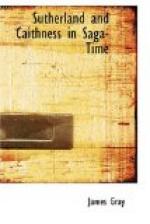Earl Harold had put his wife Afreka away, and probably after Sweyn’s death formed a union, at a date which it seems impossible to fix, with Hvarflod or Gormflaith, daughter of Malcolm MacHeth of Moray, who was in rebellion in 1134, and was imprisoned in Roxburgh Castle until 1157, when he was released and created Earl of Ross, so that Gormflaith, who could hardly have been born during her father’s imprisonment, must have been born either before 1135 or after 1157. Harold and Gormflaith’s children were Thorfinn, who predeceased him, and also David and John, both afterwards in succession earls of Caithness and jarls of Orkney, and three daughters, Gunnhilda, Herborga, and Langlif; and of the daughters the Saga-writers tell us nothing, except that the Icelander Saemund, Magnus Barelegs’ grandson, wished to marry Langlif but did not do so;[4] and her son Jon Langlifson, according to the Saga of Hakon was in 1263 a spy on the Norse side.
Here the Orkneyinga Saga ends. But additions to its generally received text are found in the Flatey Book,[5] and the additions are by no means so trustworthy as the Saga proper. From these we learn that of Eric Stagbrellir and Ingigerd’s children, who were settled in Sutherland, the sons, Harald Ungi, Magnus, and Ragnvald Eric’s son, fared east to Norway to King Magnus Erling’s son, where young Magnus Eric’s son fell with that king in the battle of Norafjord in Sogn in 1184.[6] Probably some of them were, on Eric Stagbrellir’s death, subjected to exactions in respect of their lands by Harold Maddadson.




